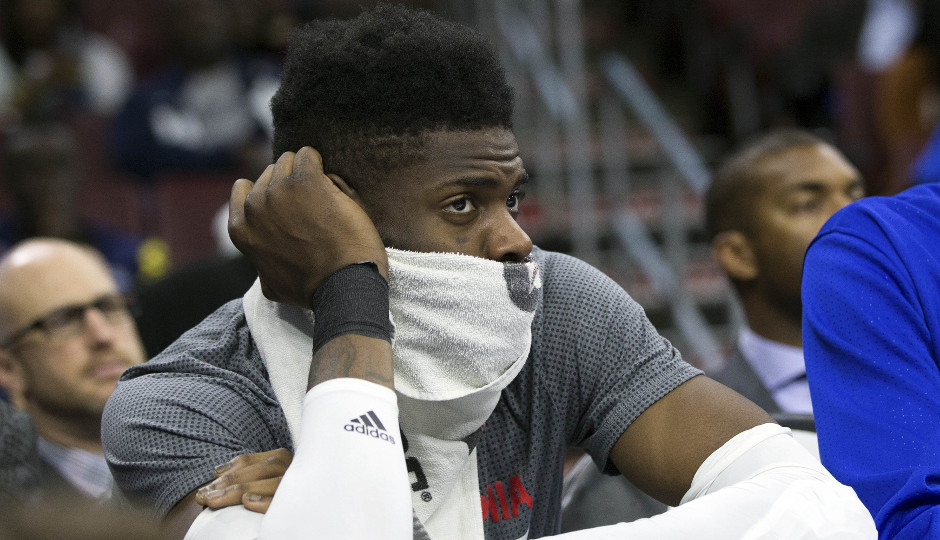Dissecting the Jeff Teague For Nerlens Noel Rumor

Nerlens Noel came off the bench to score 16 points and collect 9 rebounds in the 76ers 113-88 loss to the Charlotte Hornets | Bill Streicher-USA TODAY Sports
After rumors about pursuing a trade to acquire a second high draft pick in order to find guard help, a rumor came out of left field from Shams Charania of Yahoo Sports which states the Sixers and Hawks are discussing a trade of Nerlens Noel for Jeff Teague.
The rumored discussions for a Nerlens Noel for Jeff Teague swap is a lot to digest. Is it a good decision for the Sixers? Let’s unravel all of the layers involved.
Jeff Teague the player
Since taking over the starting point guard role in the 2011-12 season, Teague has averaged 15.1 points, 6.4 assists, and 1.4 steals per game, while shooting 45.1 percent from the field and 35.8 percent from three-point range. He’s also been very healthy, missing just 17 games during that five year span.
The advanced stats, while not exceptional, paint Teague as a quality player as well. Teague has accumulated 30.8 win shares (0.125 per 48 minutes), 6.5 VORP, and +0.2 BPM over that span. That ranks 14th (win shares), 26th (VORP), and 45th (BPM) among guards, according to the basketball-reference database.
There’s no advanced statistic that encapsulates everything a player brings to the table, and such rankings not meant to represent a player’s exact positioning in the league. But they’re usually pretty decent at placing somebody in a range, and I think where it places Teague among his peers (a borderline top-10 to top-15 point guard) is fair.
Teague’s last season contained some positive developments, along with some negative ones as well. He shot 40 percent from three-point range, easily the best of his career, which is important because three-pointers now made up 27.8 percent of his field goal attempts, once again the highest mark of his career. I’m not sure that’s sustainable — Teague shot 34.1 percent on 909 three-point attempts up to his age 27 season, so that kind of drastic improvement would be surprising if it was truly sustainable — but it’s certainly a positive in his stat sheet.
The downside if that after two seasons with a free-throw rate of roughly 36 percent, that fell to just 31.6 percent this past year. That’s not entirely surprising, as more three-point attempts usually means less fouls drawn, it’s still a downward trend, and something that could impact his efficiency down the line, especially if he begins to lose a step.
Teague also averaged just 5.9 assists per game, his lowest since 2011-12, but that is mostly explained by a slight drop in minutes, and also Dennis Schroder having the ball in his hands more.
Jeff Teague the contract
Jeff Teague by himself isn’t a bad player to acquire. If Teague had three more years left on his deal, rather than just one, the acquisition would make a little bit more sense.
But Teague is set to hit free agency at just the right time.
The cap, which was set at just $70 million for the 2015-16 season, is set to jump to $92 million for 2016-17 and $107 million for 2017-18. This means Teague would be eligible to receive a pay bump from his $8 million in 2016-17 to roughly $30.5 million in 2017-18.
Now, that doesn’t mean Teague is necessarily going to get a max contract. And, for as bad as that numbers looks on first glance, what you really care about is what percentage of the cap that would represent. But beyond the sticker shock the huge jumps in the salary cap over the next two seasons also means more teams than ever will have salary cap space to spend.
More teams with money to spend means good players will get overpaid, especially 29-year-old players on a bad team looking to sign the last major contract of their career. If Teague is going to risk losing the certainty of winning — and let’s be honest, even the most optimistic of projections aren’t going to have the Sixers winning a ton of games next year — he’s not going to do it at a discount. With a market that is already set to overpay average players, overpaying the overpay for a point guard who will begin his next contract at 29 years of age is a recipe for disaster, especially for a team that will still be as young as the Sixers are.
How will Jeff Teague age?
With Teague having just finished up his 27-year-old season, he’s entering the end of his physical prime. Not now, of course. There’s a reasonable assumption that he’s still going to play at a high level the next two years.
But aging is a real life thing, and its impact unavoidable. We tend to ignore the impact of aging until you actually start to see the negative consequences of it, but history suggest Teague is going to start declining soon.
Here are two quick graphs to show aging in effect. The data is from Neil Paine and is a couple of years old, but still relevant, as the Fountain of Youth has not yet been located.
The first shows the change in win shares, per 3,000 minutes, over the previous season. So, basically, if a player produced 3 win shares as a 20-year-old rookie, then 3.7 win shares during his 21-year-old season, his 21-year-old season would be labeled “+0.7”. A positive number means he improved, and a negative number means he declined.
According to that data, which looked at all seasons from 1978 to 2009 with at least 2,000 minutes played, players typically start showing signs of decline at the age of … 28, the exact season Teague is about to enter.
According to that same article, guards tend to peak a little bit earlier. From data in the article, here is what age guards typically have their most productive seasons at.
All of this suggests that it’s likely Teague’s eventual decline is sooner rather than later. Not necessarily precipitous, but a process that is likely to start. Yet, by the nature of NBA contracts (which ties maximum salary to years of experience in the league), and by the climate he’s going to be paid in (with a rising cap and more teams than ever having space), Teague’s salary, either in terms of raw earnings or percentage of the cap, is going to be trending upwards while his play is likely trending downward.
Jeff Teague’s fit with Ben Simmons
One of the benefits of drafting Ben Simmons is that Simmons will initiate much of your half-court offense. This thrusts the point guard spot into more of a secondary role in your offense.
By limiting the responsibilities of the point guard position it should allow you to go out and target guys that were previously overlooked because they couldn’t perform an action on the basketball court typically deemed necessary from the point guard spot. After drafting Ben Simmons, the Sixers are now able to go out and pursue these kind of overlooked players because they can fit the Sixers’ unique situation. Instead of using that to their advantage, the Sixers would, instead, be surprisingly willing to overpay for a win now point guard that has spent the majority of his time creating out of pick and roll sets with the ball in his hands.
(*Note: there’s also the very real chance that playing next to a ball-dominant power forward will limit Teague’s opportunity, and thus limit his value. I’m not even touching on this in any depth, but it’s absolutely a factor).
Teague doesn’t fit the Sixers timeline
Overpaying Teague in the summer of 2017-18 might make sense for a contender, a team who is steady point guard play away from legitimately competing, and a team who can bite what seems like the inevitable bullet that will be the last half of the contract because the production in the first half of the contract will be so valuable for the team. That’s not the Sixers.
If you look at the Sixers as potentially having two elite young talents (Ben Simmons and Joel Embiid), neither are likely going to be ready to really compete, at a league-wide level, for another 3-4 years. Until then it’s about developing Embiid and Simmons, while also finding complementary pieces who will hopefully still be relevant when that time does come.
Teague doesn’t fit that timeline at all. By the time Embiid and Simmons are really ready to be focal points of a team making an extended playoff run, Teague will be on the wrong side of 30. As the above graphs show, that’s not usually the sweet spot of a players career, and that’s likely to be especially true for a player like Teague who relies on his athleticism quite a bit. Perhaps, maybe, Teague’s improved three-point shooting suggests he can defy the typical aging curve, but I’m not ready to buy that Teague is a 40 percent three-point shooter going forward, nor am I ready to bet that he can be the exception to the aging curve. Not a bet of at least $20 million per year and losing Nerlens Noel, at least.
Nerlens Noel is seriously underrated
Part of the underlying argument here is that Nerlens Noel is seriously underrated.
We tend to evaluate players like a balance sheet, with positive attributes on one side, negative attributes on the other, and if the positive outnumber the negative then that player is a “good” player.
Except that’s not really how it works. People who are elite at something can provide teams with a real competitive advantage. That is especially true for big men who are elite team defenders.
I’ve frequently made the case that rule changes over the past 20 years have made pick and roll defense, weakside rotations, and the ability to switch screens more important than ever. Hand checking has made it easier for guards to penetrate, illegal defense rules have made it easier to space the floor, and the reaction to that has been for teams to prioritize floor spacing above all else in order to maximize their guards ability to create off the dribble.
The answer to that, defensively, has been big men who can cover ground, switch all pick and rolls and ball screens, and cover up any leaks in the perimeter of a defense.
So whether or not Nerlens Noel, who just played his second professional season at 21 years of age, is currently a great post defender, or a consistent contributor on offense, doesn’t mean he doesn’t have a profound impact on the game. Basketball is about more than just the ability to score 1-on-1, and Nerlens Noel’s value is underrated, in my opinion.
And we have recent evidence that Noel can anchor a top defense, as the Sixers, led by Noel’s 1.9 blocks and 1.8 steals per game as a rookie, finished 12th in the league in defense during Noel’s rookie season. That was as a rookie, and on a team without much NBA talent.
This year was obviously a tough one for Noel, who fought lingering knee injuries, was out of position for much of the year, and struggled to make up for one of the worst collection of perimeter defenders in the league. Even so, with Noel on the court and Jahlil Okafor off, the Sixers yielded 104.0 points per 100 possessions, the 16th best rating in the league. Considering he was covering up for Ish Smith, Nik Stauskas, Isaiah Canaan, and so on, 16th is about the best you can hope for. When joined by more competitive talent, and at his natural position, we already have proof of what Noel can provide.
Still, even with playing out of position, Noel has accumulated 251 steals and 242 blocks so far in his two-year career. Here’s an extensive list of players who accumulated at least 250 steals and 240 blocks in the first two seasons of their NBA careers, dating back to the 1973-74 season, when steals and blocks were first recorded:
- David Robinson
- Nerlens Noel
That is all.
Furthermore, Noel’s 4.0 defensive box plus/minus is 7th best in NBA history for players just two years into their career (minimum 2,000 minutes played), just barely behind David Robinson and ahead of guys like Tim Duncan, Sam Bowie, Andrei Kirilenko, and Draymond Green.
Scoring numbers jump out. I get it. Putting up incredibly unique offensive output will garner more attention than steals or blocks. But what Nerlens Noel is doing is unique itself, and even more valuable in today’s NBA.
There is an argument that Noel will never reach his defensive peak playing alongside Joel Embiid. I can buy that. But two things: 1) That doesn’t mean this trade is good. 2) Arguing that you can’t rely on Joel Embiid, then arguing you should trade Nerlens Noel away for an aging point guard because of Joel Embiid, seems kind of contradictory.
The 2017 draft is stacked at the point
The 2017 draft class looks stacked at the point guard spot, with Markelle Fultz (2nd in DraftExpress.com’s current mock draft), Frank Ntilikina (5th), Dennis Smith (6th), De’Aaron Fox (11th), and Lonzo Ball (14th) all looking like potential long-term fixtures at the position. The class projects to be one of the more loaded ones in recent memory, and the Sixers, by virtue of their top-3 protected pick from the Los Angeles Lakers and pick swap rights with the Sacramento Kings, have a very high chance of having two top-10 selections.
If the Sixers are sitting there on draft night next year, with a 29-year-old Jeff Teague about to become a free agent and the best player on the board is a point guard, you better believe they’re going to entertain drafting their new point guard of the future. If there’s a very real chance that Jeff Teague’s eventual replacement is available in next year’s draft, paying either price (Nerlens Noel or Jeff Teague’s next contract) makes little sense.
Conclusion
The great trades are ones that have multiple different ways that can turn out to be a positive for your team.
With this deal, I’m not sure which result is “winning”. Is it better to trade away 22-year-old center who has already shown he can anchor a defense for a one year rental at point guard, or to trade away a 22-year-old defensive anchor for the chance give a league-average player at the deepest position in the league a humongous contract right at the time he exits his physical prime, on a team that isn’t ready to compete?
There’s some value in finding a stabilizing presence to help Simmons and Embiid grow. I fully buy into that. Finding that presence should be a goal this season.
But this would be an overpay. This would be an overpay in terms of what you’re giving up, which is a center who just turned 22 and has shown he can be a defensive force. This is an overpay because of the abundance of quality point guard options in the NBA, a surplus which should help you find an acquisition price that is more agreeable to your situation without giving up one of your most talented pieces. This is an overpay because of the contract Jeff Teague is about to receive, a contract that kicks in right when there will be more teams than ever able to bid for his services, and right at the tail end of his physical prime.
Jeff Teague is a good basketball player who is a bad fit for the Sixers’ current situation. This would be rushing to field a competitive team, and paying drastic consequences for it.
Hopefully, this is a rumor that doesn’t have legitimate legs. Just one of the many not-even-close-to-being-finalized trades currently being discussed, and is being floated about to generate further interest in Okafor and Noel from teams around the league, or by Teague’s agent to generate interest in his client who will be a free agent next summer.
Still, with the inevitability of change hanging over the Sixers, the team runs the risk of letting the realities of their current situation (too many big men, not enough guards) force themselves into a move that makes little sense long term. Hopefully, this isn’t a sign of things to come.
Derek Bodner covers the 76ers for Philadelphia magazine. Follow @DerekBodnerNBA on Twitter.


